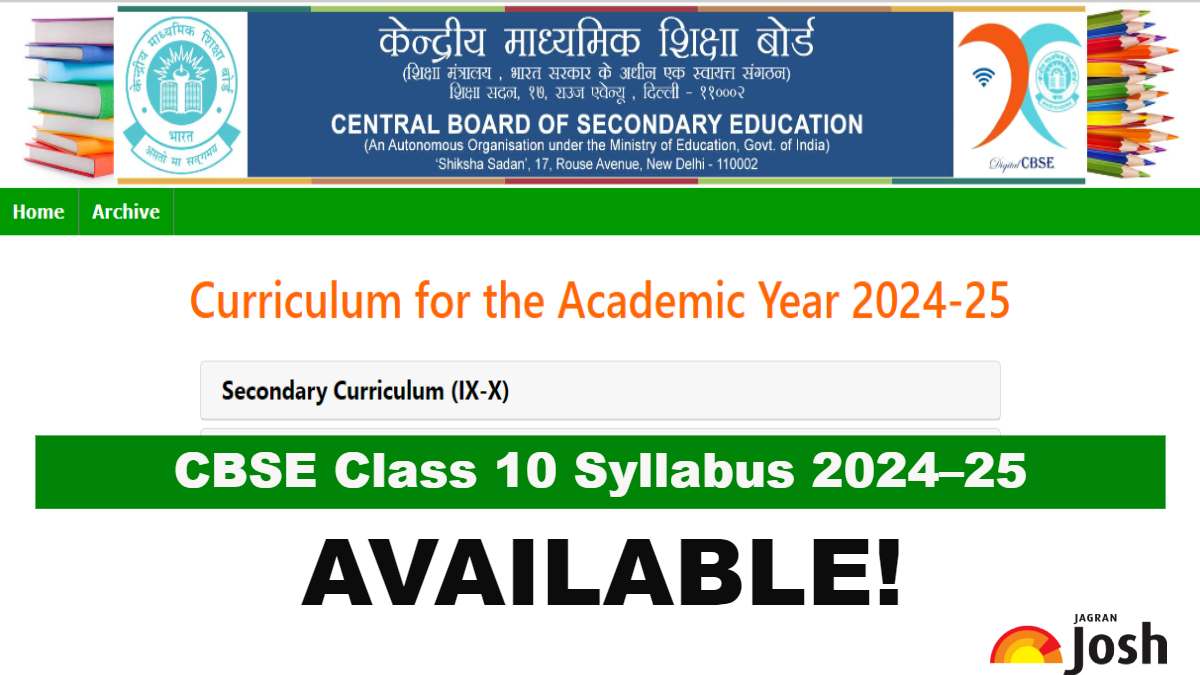CBSE Class 10 Syllabus 2024-25: Latest and Revised FREE PDFs
CBSE Class 10 Syllabus 2024-25: Latest and Revised FREE PDFs Jagran Josh



CBSE Syllabus 2025 for Class 10:
The Central Board of Secondary Education (CBSE) 2024 board exams for Class 10 are over, and the new academic session will begin. This new year will be named 2024–25. In the academic year 2024–25, the CBSE Board released the latest Class 10 Syllabus 2025. The syllabus is out for the compulsory and optional subjects in PDF format.
The new syllabus for CBSE 10th is a new initiative to improve the classroom and school environment by encouraging the holistic development of students. According to CBSE, “The secondary education curriculum is a major step in giving shape to the nation’s vision of education. It aims to provide education that addresses local, national, and global needs.”
Here, the CBSE Class 10 syllabus 2024–25 is provided for Maths, Science, Social Science, Hindi, English, and other elective subjects in PDF format. You can scroll down and download the PDFs from the link provided below.
CBSE Class 10 Curriculum Areas
CBSE’s motto is to support the all-round development of the students with a holistic approach that educates them for society and themselves. The secondary curriculum of CBSE provides students with a comprehensive knowledge of subjects that include languages and other core subjects. The CBSE curriculum focuses on the major learning areas under the following:
|
Languages 1
|
Compulsory
|
|
|
Languages 2
|
||
|
Social Science
|
||
|
Mathematics
|
||
|
Skill based Subject/ Elective Subject
|
||
|
Language 3
|
||
|
Health and Physical Education
|
Compulsory Subjects having only school based internal assessment
|
|
|
Work Experience
|
||
|
Art Education
|
CBSE Class 10 Syllabus 2024-25
Here, you will get the subject-wise 2024 CBSE Class 10 syllabus. These syllabi are the latest and include all the revisions that CBSE would have thought of for the new academic year. Download these files and keep them for future reference.
CBSE Class 10 Syllabus 2025 for Main Subjects (Group A1)
CBSE Class 10 Syllabus 2025 for Languages (Group L)
CBSE Class 10 Syllabus 2025 for Other Academic Electives (Group A2)
CBSE Secondary School Curriculum Salient Features
The CBSE Board in its introduction to the secondary curriculum have mentioned its salient features. The Curriculum prescribed by CBSE strives to:
- i. provide ample scope for holistic i.e., physical, intellectual and social development of students;
- ii. emphasize constructivist rather than rote learning by highlighting the importance of hands-on experience;
- iii. enlist general and specific teaching and assessment objectives to make learning competency-based and attain mastery over laid down competencies;
- iv. encourage the application of knowledge and skills in real-life problem-solving scenarios;
- v. uphold the ‘Constitutional Values’ by encouraging values-based learning activities;
- vi. promote 21st Century Skills, Life Skills, Financial Literacy, Digital Literacy, Health and Wellness, Road Safety, Citizenship Education, Disaster Management and multilingualism;
- vii. integrate innovations in pedagogy such as experiential, activity-centered, joyful learning, Sport & Art-Integrated Learning, toy-based pedagogy, storytelling, gamification etc. with technological innovations (ICT integration) to keep pace with the global trends in various disciplines;
- viii. promote inclusive practices as an overriding consideration in all educational activities;
- ix. enhance and support learning by different types of assessments; and
- x. strengthen knowledge and attitude related to livelihood skills;
- xi. foster multilingual and multicultural learning and national understanding in an interdependent society;
- xii. integrate environmental education in various disciplines from classes I- XII.
How to Download CBSE Class 10 Syllabus 2025?
The CBSE 2024–25 curriculum is out! Students and teachers can download the syllabus PDF for all the subjects by following the steps mentioned below:
Step 1: Visit the official website of the Central Board of Secondary Education (CBSE) at cbseacademic.nic.in.
Step 2: Click on the section labelled “Curriculum.”
Step 3: Click on the link or tab mentioning “Curriculum 2024-25.”
Step 4: Download the syllabus PDF.
Having the latest syllabus is mandatory and is the first resource you need to crack your board exams. Thus, students should always keep a copy of the syllabus with them.
Also Read:
SDGs, Targets, and Indicators in the Article
-
SDGs Addressed or Connected to the Issues Highlighted in the Article:
- SDG 4: Quality Education
- SDG 5: Gender Equality
- SDG 8: Decent Work and Economic Growth
- SDG 10: Reduced Inequalities
- SDG 11: Sustainable Cities and Communities
- SDG 12: Responsible Consumption and Production
- SDG 16: Peace, Justice, and Strong Institutions
- SDG 17: Partnerships for the Goals
-
Specific Targets Based on the Article’s Content:
- Target 4.1: By 2030, ensure that all girls and boys complete free, equitable, and quality primary and secondary education leading to relevant and effective learning outcomes.
- Target 4.7: By 2030, ensure that all learners acquire the knowledge and skills needed to promote sustainable development, including, among others, through education for sustainable development and sustainable lifestyles.
- Target 5.5: Ensure women’s full and effective participation and equal opportunities for leadership at all levels of decision-making in political, economic, and public life.
- Target 8.6: By 2020, substantially reduce the proportion of youth not in employment, education, or training.
- Target 10.2: By 2030, empower and promote the social, economic, and political inclusion of all, irrespective of age, sex, disability, race, ethnicity, origin, religion, or economic or other status.
- Target 11.3: By 2030, enhance inclusive and sustainable urbanization and capacity for participatory, integrated, and sustainable human settlement planning and management in all countries.
- Target 12.8: By 2030, ensure that people everywhere have the relevant information and awareness for sustainable development and lifestyles in harmony with nature.
- Target 16.7: Ensure responsive, inclusive, participatory, and representative decision-making at all levels.
- Target 17.16: Enhance the global partnership for sustainable development, complemented by multi-stakeholder partnerships that mobilize and share knowledge, expertise, technology, and financial resources.
-
Indicators Mentioned or Implied in the Article:
- Indicator 4.1.1: Proportion of children and young people (a) in grades 2/3; (b) at the end of primary; and (c) at the end of lower secondary achieving at least a minimum proficiency level in (i) reading and (ii) mathematics, by sex.
- Indicator 4.7.1: Extent to which (i) global citizenship education and (ii) education for sustainable development are mainstreamed in (a) national education policies; (b) curricula; (c) teacher education; and (d) student assessment.
- Indicator 5.5.1: Proportion of seats held by women in (a) national parliaments and (b) local governments.
- Indicator 8.6.1: Proportion of youth (aged 15-24 years) not in education, employment, or training.
- Indicator 10.2.1: Proportion of people living below 50 percent of median income, by age, sex, and persons with disabilities.
- Indicator 11.3.1: Ratio of land consumption rate to population growth rate.
- Indicator 12.8.1: Extent to which (i) global citizenship education and (ii) education for sustainable development are mainstreamed in (a) national education policies; (b) curricula; (c) teacher education; and (d) student assessment.
- Indicator 16.7.1: Proportions of positions (by sex, age, persons with disabilities, and population groups) in public institutions (national and local legislatures, public service, and judiciary) compared to national distributions.
- Indicator 17.16.1: Number of countries reporting progress in multi-stakeholder development effectiveness monitoring frameworks that support the achievement of the sustainable development goals.
Table: SDGs, Targets, and Indicators
| SDGs | Targets | Indicators |
|---|---|---|
| SDG 4: Quality Education | Target 4.1: By 2030, ensure that all girls and boys complete free, equitable, and quality primary and secondary education leading to relevant and effective learning outcomes. | Indicator 4.1.1: Proportion of children and young people (a) in grades 2/3; (b) at the end of primary; and (c) at the end of lower secondary achieving at least a minimum proficiency level in (i) reading and (ii) mathematics, by sex. |
| SDG 4: Quality Education | Target 4.7: By 2030, ensure that all learners acquire the knowledge and skills needed to promote sustainable development, including, among others, through education for sustainable development and sustainable lifestyles. | Indicator 4.7.1: Extent to which (i) global citizenship education and (ii) education for sustainable development are mainstreamed in (a) national education policies; (b) curricula; (c) teacher education; and (d) student assessment. |
| SDG 5: Gender Equality | Target 5.5: Ensure women’s full and effective participation and equal opportunities for leadership at all levels of decision-making in political, economic, and public life. | Indicator 5.5.1: Proportion of seats held by women in (a) national parliaments and (b) local governments. |
| SDG 8: Decent Work and Economic Growth | Target 8.
Behold! This splendid article springs forth from the wellspring of knowledge, shaped by a wondrous proprietary AI technology that delved into a vast ocean of data, illuminating the path towards the Sustainable Development Goals. Remember that all rights are reserved by SDG Investors LLC, empowering us to champion progress together. Source: jagranjosh.com
Join us, as fellow seekers of change, on a transformative journey at https://sdgtalks.ai/welcome, where you can become a member and actively contribute to shaping a brighter future.
|








